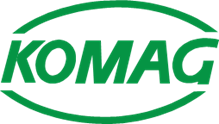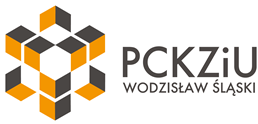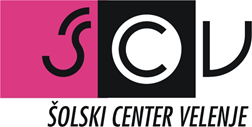KOMAG 
About KOMAG
The institutions, from which KOMAG Institute of Mining Technology originated, have been subjected to complicated organizational and restructuring changes. The origin of our Centre goes back to the Central Design Bureau in Swietochlowice and the Mining Mechanization Plant of the Central Institute of Natural Fuels in Katowice, established in 1945.
A development of the mining industry has caused that the Central Design Bureau was transformed into the Design Bureau of Mining Machines, which after some time took the name of the Central Bureau for Mining Machines’ Design, having its seat in Gliwice. The next step involved an establishment of the Experimental and Design Institute of the Mining Industry in 1957, which in the same year took the name of the Design and Mechanical Works of the Mining Industry (Zaklady Konstrukcyjno-Mechanizacyjne Przemyslu Weglowego – ZKMPW). An establishment of ZKMPW created a possibility for a development of the research and design basis for underground mining of coal. Scientific and research projects in the domain of coal cutting and loading processes, transportation of the run-of-mine, roof supports as well as tests of colliery electrification systems and the electric equipment of mining machines were developed. A development of ZKMPW included an establishment of the Mining Electronic Plant in Tychy, “Elektrometal” in Cieszyn and the Works of Cybernetic Mining Systems in Biskupice. The M-300 Experimental Mine and the “Jan” Automated Colliery were taken over. Then the Construction Works of Experimental Machines was created next to the M-300 Experimental Mine. The Training Centre for Machinery Operators became transformed into the Staff Improvement Centre. The Construction Plant of Experimental Machines, the M-300 Experimental Mine and the Staff Improvement Centre were separated at the beginning of 1975 and the Central Project and Design Bureau of Mining Machines – KOMAG in Gliwice, having the status of a research and development centre, was established then.
This Bureau was organizationally subjected to the POLMAG Association of Mining Machinery Producers, which associated all the Polish factories of mining machines and equipment. POLMAG enabled to establish close links between machinery designing processes and a production of machines and equipment. In fact KOMAG became the design, research and development basis for all the factories, incorporated in the POLMAG Association. On their premises KOMAG established its local branches (FAMUR, FAZOS, TAGOR, RYFAMA and GEORYT).
Then the ORTEM Design and Technological Centre for Mining Machines was incorporated in and the scope of KOMAG’s activity was broadened by the issues of manufacturing techniques of mining machines and equipment as well as by the issues of production organization and management. It was also decided to change the name for the Design and Technological Centre of Mining Machines and afterwards, when the following reorganization was introduced, for the KOMAG Mining Mechanization Centre. Since 1st January 2009 KOMAG acts as Institute of Mining Technology KOMAG.
The KOMAG scope of activity includes scientific, research and development projects in the domain of minerals mining and processing as well as environment protection and work safety connected with them, but also air and ground surface protection, waste management and an adaptation of research results for a practical implementation and their dissemination in other natural and technical sciences.
PCKZiU 
About PCKZiU
Powiatowe Centrum Kształcenia Zawodowego i Ustawicznego (PCKZiU) was established on 1 September 2016 as a combination of two schools including Zespół Szkół Zawodowych (ZSZ) and Powiatowe Centrum Kształcenia Ustawicznego (PCKU). Both schools have more than ten years of history, tradition and many achievements in teaching both young and adult students.
PCKZiU continues the tradition of the schools of which was established and offers the wide range of vocational training. It offers young people and adults a variety of courses, such as environmental protection, analytics, electricity, mechanics, mechatronics, electromechanics, ironwork and mining.
We meet the expectations of employers who need well-educated, skilled and specialized personnel. We systematically raise the effects of standards of vocational training. One of the ways to raise the effects is to work with 3D incubator located in the Simulated Company, which was established within the walls of our school and promotes 3D technology.
PCKZiU is a modern educational center open to the needs of our society, as well as the changes of a labor market. There are places for people who are interested in getting both the general and vocational education.The structure of our institution was designed in a way that can easily meet the individual needs of each student. Students graduated from junior high schools may choose a technical or vocational school and lessons for them are conducted in a full-time system starting from the morning. Adult students may learn either in the evening or weekend system in a high school or on qualifying vocational courses. After completion of the required number of courses and the secondary education students get the diploma.
Both schools that formed PCKZiU have a long tradition in the implementation of the European programs, which contribute to the successful pass rate of vocational exams, thanks to the exchange of experiences. Our institution cooperated with schools from the Czech Republic, Turkey, Italy, Hungary and Slovenia. The funds we gained from the European programs allowed our students and teachers to improve their professional, linguistic and cultural skills.
We participated in the following projects:
Leonardo da Vinci "Building the common future" (ZSZ as a project coordinator)- the aim of the project was to increase the practical skills, as well as to create and to program mechatronic devices.The two main successes of the project was winning the first place in the contest LEO-ON-line for the most interesting website within the project Leonardo da Vinci and the second place of the final product in the III International Robot Tournament "Robotic Tournament" in the category of Free Style.
Comenius Project "I will be a student!" (ZSZ as a project coordinator)- the main objective of the project was to promote higher education, as well as to make students aware that a united Europe needs people who are fluent in foreign languages.
Leonardo da Vinci "Tommorow Becomes Today - Student Made Advanced Real Technology" (ZSZ as a project coordinator, the project realized with PCKU) - the aim of the project was the progress of special professional competence of both students and teachers. Students developed mechatronic devices and then created control applications.
Leonardo da Vinci "Underground in the Cloud" (PCKU as a project coordinator). The aim of the project was to create e-learning mining courses on a Moodle platform in national languages (Polish, Czech and Slovenian) and in English.
IBV 
About IBV
Biomechanics Institute of Valencia (IBV) is a technological centre focused on scientific research, technological development, technical assessment and training in the biomechanical field. IBV is composed out of a multidisciplinary team formed by around 150 persons including mechanical and product engineers, biomechanical and movement science engineers, medical doctors, physical therapists, podiatrists and physics among others.
The aim of IBV is to improve quality of life, as well as competitiveness of companies and self-employed people. The IBV works in the following areas of expertise, providing high-value services and products: automotive and mass transport, sports, habitat, clothing and footwear, elderly people, rehabilitation and personal autonomy, occupational health and safety, healthcare technology, tourism and person-oriented-design.
IBV offers specialised education and training in order to transfer knowledge and research results in the field of biomechanics, health and well-being technologies. Courses are addressed to organisations and professionals working in commercial or industrial sectors where this knowledge is required. IBV offers face-to-face and e-learning courses in Spanish and in English, both monographic courses closely related to the IBV’s fields of action and tailored courses adapted to the user’s needs. Contents of the courses are developed by IBV researchers or are the result of cooperation with other RTD and education centres under the framework of European and national projects.
IBV currently offers 21 vocational training online courses at its "Virtual Campus IBV" among which 4 of them are the result of completed LLP-LdV projects. IBV participates in a Master of Biomedical Engineering and a Master in Occupational Risk Prevention (conjointly offered by the Polytechnic University of Valencia and the University of Valencia), in a Degree of Biomedical Engineering offered by the Polytechnic University of Valencia and has his own Master of Clinical Biomechanics Assessment with the collaboration of the Polytechnic University of Valencia.
SCV 
About SCV
School Centre Velenje is one of the largest Vocational Education and Training (VET) centres in Slovenia with more than 55-year long tradition and with 3115 students on initial and continuous secondary and also higher level of education, serving by 223 teachers, trainers and other staff. It consists of School of Coal-mining, School of Mechanical Engineering, School of Electrical Engineering and Computing, School for Service Activities, Gymnasium, Higher Professional School and Inter-company Training Centre. Modern role of staff and teachers as professionals, innovators, project managers, mentors, colleagues with experience in usage of ICT, lifelong learning concept, and adult education reflects the integration of the education institution in the priorities of the regional and local development. Special focus is on partnership cooperation with local and regional economy as well as on cooperation with companies in national and European context. According to the challenges of actual time School Centre Velenje tries to provide quality educational services and to carry out education on responsible way for all participants of education.
Special unit of School Centre Velenje is Inter-company training centre, where development and promotion of activities relating to the quality of life, lifelong learning and better business results are implemented.
Fast-developing technology as well as continuous demands for new knowledge and skills require constant search for new knowledge, investment into own development, lifelong learning, competent and responsible actions, good cooperation and teamwork. Therefore the cooperation with domestic and foreign partners is of high importance for School Centre Velenje.
Apart from its main sphere of activity the School Centre Velenje has also developed cooperation with domestic and foreign partners, beginning in the year 1973. As project coordinator and as project partners School Centre Velenje has participated in various EU projects since 1996 (Erasmus+, Lifelong Learning, Intelligent Energy Europe, ICT Policy Support Programme, IPA, Phare ...).
EXOVITE 
About EXOVITE
Exovite (Hermo Medical Solutions, S.L.) is a medical device development SME company, based in Spain, that intends to design, patent, and market medical devices aimed to improve healing processes provided to treat broken bone and muscle injuries. Exovite’s mission is to improve patient quality of life by improving his or her healing processes, eliminating unnecessary visit to hospitals and clinics, and saving time and money to all parties involved in rehabilitation course. The project will be managed directly by CEO Juan Monzon. The rest of the organizational structure include financial, sales, engineering and R&D departments with 7 people (expertise in 3D imaging, 3D printing, traumatology, mechanical and electronic engineering, CE and FDA regulation, marketing and business development) working on them.
Vision: “To reduce traumatology rehabilitation and medical days off using new technologies and improving patients life.”
Mission: Exovite develops a system for treatment of broken bones and muscle injuries that improves patient quality of life by improving his or her healing processes, eliminating unnecessary visit to hospitals and clinics, and saving time and money to all parties involved in rehabilitation course.
Values:
- Customer focus: improving the daily lives of patients and health personnel receiving and providing immobilization and rehabilitation treatments.
- Long-term perspective: The m-Health and Tele-RHB are growing markets with many possibilities for new products. Also 3D printing for medicine.
- Quality and Innovation: Exovite aims to be an innovative company with high quality products.
- Initiative and Responsibility: principles that meet all the members of the company.
- Transparency, collaboration, customer oriented and fun the pillars of our way of working.
- Corporate Social Responsibility: We believe that our employees, collaborators and customers have to enjoy of their work and personal life.
The future of medical processes include systems that allow control of therapy with an application managed by the medical staff (m-Health) and facilitates most of the treatment in patients' homes (e-Health). Exovite strategy is focused in these kind of services, combined with the latest technology: scanning and 3D printing. The technological value and innovation of Exovite’s solution is one of its main advantages allowing positioning it in both the current and future market as a viable alternative to conventional solutions.







